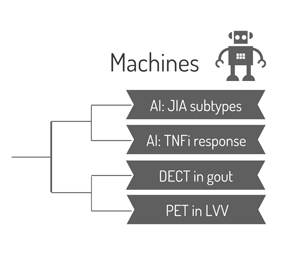 Editor’s note: RheumMadness is the place for everyone crazy about rheumatology to connect, collaborate, compete and learn together. During RheumMadness, rheumatology concepts represent teams that compete against each other in a tournament, much like basketball teams do in the NCAA’s March Madness tournament. In a series for The Rheumatologist, readers will get a chance to read the scouting reports for each concept team. These reports are written by rheumatology fellows from 13 programs throughout the U.S.
Editor’s note: RheumMadness is the place for everyone crazy about rheumatology to connect, collaborate, compete and learn together. During RheumMadness, rheumatology concepts represent teams that compete against each other in a tournament, much like basketball teams do in the NCAA’s March Madness tournament. In a series for The Rheumatologist, readers will get a chance to read the scouting reports for each concept team. These reports are written by rheumatology fellows from 13 programs throughout the U.S.
Don’t forget to submit your RheumMadness 2022 bracket by March 25. The more your picks match those of our Blue Ribbon Panel of rheumatologists, the more points you get. Learn more about the panel and how the brackets work online.
Connect with RheumMadness by subscribing to the podcast and joining the conversation on Twitter, #RheumMadness. Learn more on the RheumMadness website.
Region: Machines Team: AI: JIA Subtypes
Juvenile idiopathic arthritis (JIA) is the most common pediatric rheumatologic condition, affecting up to 300,000 children in the U.S., in total. Although in adult medicine our colleagues take care of patients under the single diagnosis of rheumatoid arthritis (RA), here in pediatrics we like to complicate things. The current pediatric classification criteria—the 1995 International League of Association of Rheumatology (ILAR) criteria—include seven different subtypes of JIA, namely oligoarticular JIA, rheumatoid factor (RF) positive polyarticular JIA, RF-negative polyarticular JIA, systemic JIA, enthesitis-related JIA, psoriatic JIA and undifferentiated JIA.
 As we learn more about genetic profiles and immune signatures, the discussion regarding the accuracy of these subtypes has evolved. These discussions have challenged how we stratify our patients’ risk, think about their prognosis and decide on treatment plans.
As we learn more about genetic profiles and immune signatures, the discussion regarding the accuracy of these subtypes has evolved. These discussions have challenged how we stratify our patients’ risk, think about their prognosis and decide on treatment plans.
Machine learning is a potential tool to help distinguish different JIA subtypes and predict treatment response. It’s a unique approach to help make predictions and classification more efficient through the use of big data analysis, similar to how your phone or Instagram account predicts what you want to buy without you even whispering it.
In this single-center, proof-of-concept study, 85 patients with JIA and 43 age-matched controls were immune-profiled via flow cytometry and machine learning.1 This study used multiple machine learning methods, including methods that sound like they’re straight out of a science fiction novel, such as artificial neural networks. Subtypes of JIA were compared and contrasted using four distinct categorizing systems:
- The ILAR criteria subtype;
- RF-positive polyarticular and systemic JIA vs. RF-negative “polygo” JIA, including RF-negative polyarthritis JIA, extended oligoarthritis JIA and persistent oligoarthritis JIA;
- Combined polyarticular and extended oligoarticular JIA vs. persistent oligoarticular JIA vs. systemic JIA; and
- Systemic JIA vs. non-systemic anti-nuclear antibodies (ANA) positive JIA vs. non-systemic ANA negative JIA.
Next, patients were classified as having active or inactive disease using the Wallace criteria. Ultimately, the most consistent finding was that systemic JIA stood out as having a distinct and unique immune signature when compared with any other groups.
These immune signatures helped identify a shared signature of inflammation found in patients with JIA, as well as in patients with other systemic inflammatory diseases. These immune patterns were accentuated in patients specifically with systemic JIA and patients with JIA who had active disease.
In patients with active systemic JIA, a significant decrease in natural killer (NK) cell percentage was found, suggesting that quantitative changes in the signature immune dysregulation may be used as reliable markers of disease activity. Another major finding provides an algorithm generated through machine learning to distinguish JIA from healthy controls with approximately 90% accuracy.
Implications
Current: Systemic JIA has a pronounced, distinct immune pattern when compared with other JIA subtypes. This research has implications for our understanding of the pathophysiologic disease process of systemic JIA, which has also been shown through genetic profiles.2
Given the distinct pattern seen in patients with systemic JIA, restructuring classification criteria to designate it as a unique disease can be considered. Additionally, children with JIA have an immune pattern distinct from healthy children. This method can serve as a diagnostic tool for more complicated patients with a clinical presentation that poses diagnostic uncertainty.
Future: Future implications for immunophenotyping machine learning include the diagnosis, treatment and prognosis of all rheumatologic conditions. With the increase in potential immunomodulating targeted therapies, along with the classification of disease based on those same immune targets, an exciting possibility of choosing precise individualized treatment plans for our patients exists.
In pediatric rheumatology, we are accustomed to using complicated clinical algorithms to properly diagnose and treat our patients. But is this really the most accurate system? Machine learning and immunophenotyping have the potential to turn the field inside out.
Chances in the Tournament
As the only pediatric team in play, this team is the dark horse. However, the long-term clinical implications of this team are arguably more far-reaching than any other team in the Machine Region—and the entire tournament.
Despite the small number of participants in this study, the exclusion of psoriatic and enthesitis-related JIA, and the lack of attention given to race, ethnicity and environmental factors that could potentially alter immune signatures, we still believe the strengths of this article make it a crucial one. We stand an excellent chance.
Immunophenotyping machine learning has implications for more than just anti-tumor necrosis factor response in RA, like our opponents would argue. Our study shows that its implications stretch far beyond one diagnosis or two therapy choices. In fact, pediatric rheumatologists have just begun to pave the way for better classifying patients in the adult world as well. Could eight subtypes of RA actually exist, and you just don’t know it yet?
Immunophenotyping through machine learning could be the disrupter you’ve been waiting for. This study can go all the way.
Alisha Akinsete, MD, is a third-year fellow in The Children’s Hospital at Montefiore Pediatric Rheumatology Fellowship Program, Bronx, N.Y.
Malki Peskin, MD, is a second-year fellow in The Children’s Hospital at Montefiore Pediatric Rheumatology Fellowship Program, Bronx, N.Y.
Jessica Perfetto, MD, is a first-year fellow in The Children’s Hospital at Montefiore Pediatric Rheumatology Fellowship Program, Bronx, N.Y.
References
- van Nieuwenhove E, Lagou V, Van Eyck L, et al. Machine learning identifies an immunological pattern associated with multiple juvenile idiopathic arthritis subtypes. Ann Rheum Dis. 2019 May;78(5):617–628.
- Ombrello MJ, Arthur VL, Remmers EF, et al. Genetic architecture distinguishes systemic juvenile idiopathic arthritis from other forms of juvenile idiopathic arthritis: Clinical and therapeutic implications. Ann Rheum Dis. 2017 May;76(5):906–913.
 Experience All of RheumMadness
Experience All of RheumMadness
During RheumMadness, rheumatology concepts represent teams that compete against each other in a tournament, much like basketball teams do in the NCAA’s March Madness tournament. In a series for The Rheumatologist, readers will get a chance to read the scouting reports. Check out the reports from each region:
Region: Cells
Region: Animal House
Region: Machines
Region: People
• False Positive MRI in Axial SpA
Don’t forget to submit your RheumMadness 2022 bracket by March 25. The winner of each match-up is decided by a seven-member Blue Ribbon Panel of rheumatologists. The panel will vote based on which topic they think is most important to patients, providers and researchers—both now and in the future. The more your picks match those of the panel, the more points you get. The tournament results will be released in four rounds from March 26–April 4. Prizes will be given to participants with the top scores in the following categories: 1) attending/APP, 2) fellow and 3) resident/medical student. The prize is a custom RheumMadness coffee mug and a lifetime of bragging rights.
Connect with RheumMadness by subscribing to the podcast and joining the conversation on Twitter, #RheumMadness. Learn on the RheumMadness website.



